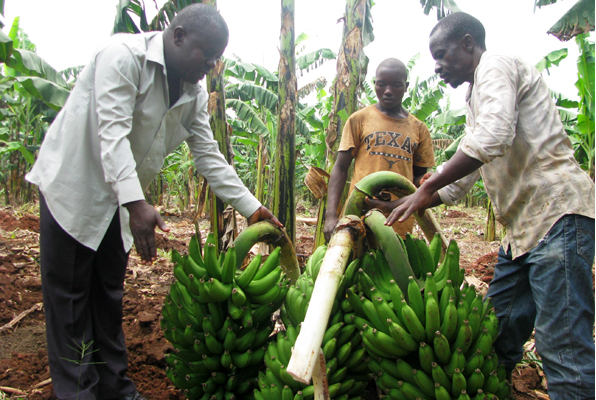As a retailer, Joseph Kizito Luwalira quickly realised that he was not going to make ends meet. He told Fred Muzaale how supplementing his income by growing banana changed his livelihood. My name is Joseph Kizito Luwalira. I am a resident of Nakaliro village in Kayunga Town Council, Kayunga District. I am a commercial farmer and I own six acres of banana, 70 acres of sugarcane and five acres of coffee. Altogether, I have 81 acres of land on which I carry out these projects. But before I joined farming in 2000, I was a businessman and I owned a retail shop in Kayunga Town. Alongside the shop, I owned a coffee processing factory and a maize mill. Initially, these businesses brought in good money which enabled me to fend for my family. But the profits from the coffee factory and maize mill dropped significantly when power tariffs were raised.
However, in 2005 when I went to Kabwohe in Mbarara District to buy coffee, I was amazed when I saw big and well –attended to banana plantations. I also saw many traders looking for bananas to buy. This forced me to inquire from the farmers what ‘magic’ they used to have such good banana plantations. I had earlier tried to grow bananas but my plantation was wiped out by banana weevils and banana wilt disease. So I had abandoned banana growing. I was surprised when they told me that they only used cow dung as fertiliser in their banana plantations and also ensure they mulch their gardens, which guarantees high moisture content in the soil all the time. The mulches also control weeds. When I returned home, I decided to give it a try, given that I was no longer realising profits from the coffee factory and maize mill.
I decided to start growing bananas since they had a ready market, whereby buyers look for the produce. Secondly, bananas give income (money) to the farmer throughout the year unlike coffee, which has only two seasons a year. Setting out to start my banana plantation, I went to Kawanda Agricultural Research Institute, where I was given free banana suckers under the NAADS programme. Because I wanted banana varieties that are drought and disease resistant yet with big bunches, I chose indigenous banana varieties such as Musakala, Kibuzi, Ssiira, Mbwa zirume and Nakitembe among others. I also took few banana suckers for Mpologoma variety because despite having a big bunch and maturing fast, this variety is highly susceptible to drought, pests and diseases. Mpologoma variety also has very weak stems, which necessitates a farmer to buy supporting poles because if this is not done, the plants, especially those with banana can easily fall.
After clearing my garden, I dug holes of three and a half feet by three feet. I then got dry cow dung which was in powder form and poured it in the holes. I left the holes open for three months as the cow dung decomposed before planting the suckers. This is because if you plant immediately, the cow dung burns the suckers, which results in withering. I planted the suckers during light rains because heavy rains also make the suckers to rot. One month after planting, I applied Dudu cyper, an insecticide. This insecticide is mixed with Urea or NPK, which are both fertilisers before it is applied on the lower part of banana plants. With this, a farmer kills pests yet at the same time boost the growth of crops. Mulching When my banana plants were about seven months old, I mulched the entire plantation using grasses I got from swamps and sugarcane leaves. Mulching has a number of benefits such as preserving water in the soil, controlling weeds, which reduces cost of labour.
However, a farmer can also use dry banana leaves as mulches. While covering the plantation I made sure I left about three metres from the banana plant uncovered. I did so because if the mulches are placed on the plant they can lead to pests attack and withering of the plant. Care for the plantation To ensure that my banana plants are healthy, I make a herbal concoction which I apply on the banana plants to kill pests and also control diseases. I make the herbal medicine by mixing plants such as tobacco, lukandwa and luwoko leaves. I also add other ingredients such as wood ash to make the herbal, which has proved very helpful in controlling even the deadly banana wilt disease. Before I discovered this herbal medicine, I was losing about six banana plants every week. Currently, I control banana wilt by applying this concoction on affected plants. I have also begun selling the herbal medicine to banana farmers at Shs50,000 for a five litre jerry can.

